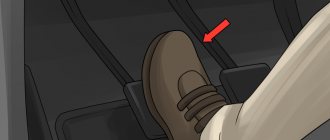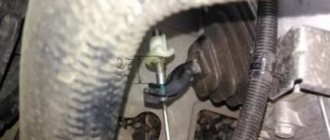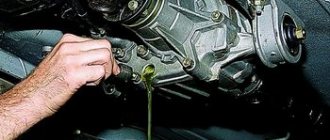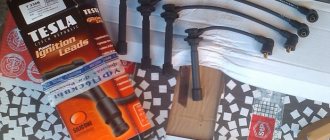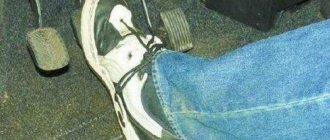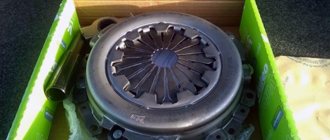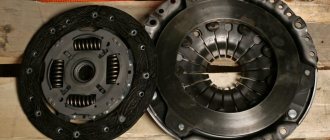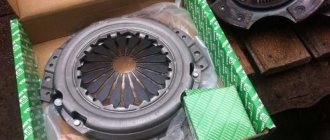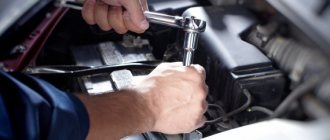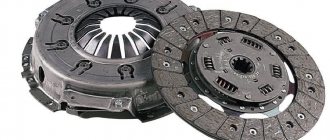Why has the clutch pedal become stiff?
If the car is completely new, then the so-called drive wedge may have occurred.
This is the easiest fault that you can adjust yourself. But if we are talking about an older car, then perhaps the problems are more serious and affect the entire unit. Most often, such problems occur due to poor performance of the diaphragm spring. It is possible that the fork is jamming or the bearing being pressed out is jammed. Cable scuffing often occurs. The driven disk itself may also become jammed.
If the car is in use for a long time, then cracks may appear on the drive fork. You also need to understand that over many years of driving a car, a large amount of dirt could simply accumulate in this unit.
Sequence of actions when removing and replacing the Lada Granta clutch with cable drive
- After removing the manual transmission (the process is described above), we mark the location of the basket and flywheel with marks. In the event that we do not plan to replace the basket or pressure plate. The decision is made by the repairman based on the diagnostic results.
Removed manual transmission
- Unscrew the bolts and remove the basket with the pressure driven disk.
Cart with disc
Note to the driver!!! We loosen the tightening of the bolts evenly, according to the diagonal principle, one turn of the key.
- Remove the discs from the clutch basket.
Removing a disc from the bin
- We carry out troubleshooting of parts, adjacent mechanisms and elements.
What to pay attention to when troubleshooting:
- cracks, breaks in parts;
- depressions of more than 0.2 mm;
- check for cracks on the diaphragm spring;
- We inspect the support rings; there should be no signs of wear, visible or obvious defects on them;
We replace worn elements with new ones as necessary.
Pedal stroke method
You can determine disc wear using the pedal stroke method. To do this, drive the car onto a level area, put the handbrake on and start the engine. When the engine has warmed up to operating temperature, put the car in first gear and slowly release the clutch without letting the car stall.
Pay attention to what position of the pedal the torque is transmitted to the wheels
If the clutch engages at the very beginning of the pedal stroke, the disc is new, and if in the middle, the friction linings are worn out by 40-50%. Seizing at the very end of the stroke or its complete absence will indicate serious wear of the disc. A burnt smell will signal the critical need for urgent replacement.
If, following the recommendations, you have diagnosed clutch wear in your car, all you have to do is purchase the necessary spare parts and make a replacement.
How to replace a release bearing - step-by-step instructions
The entire bearing replacement process is outlined below, supported by photographs for greater clarity. To replace you will need: a new release valve (suitable from Priora, but you will have to trim the “ears”); pit or lift; set of tools.
1. Work is performed on an inspection pit or on a lift. We unscrew everything that may interfere with hanging the box (protection, hanging cables, etc.).
2. Unscrew the bolts securing the box and disconnect it from the motor.
3. We hang the box on ropes without removing it completely and without disconnecting the CV joints.
4. Remove the retaining spring, then remove the faulty bearing from the guide bushing.
Reassembly is performed in reverse order; during assembly, do not forget to lubricate the shaft on which the release bearing sits. If the replacement process is not described in sufficient detail for you, you can read a more detailed report
How is the clutch adjusted?
So, how to properly adjust the clutch? The clutch of the modern VAZ model family has a clutch cable, along with which there are ratchet mechanisms in the structural unit. These cables do not provide for any clearance, which in theory does not imply the need for adjustment. However, the manufacturer insistently recommends performing periodic adjustment procedures on this mechanism.
To perform the adjustment on these cars, including the Lada Granta, you should stock up on a ruler (a caliper is also suitable) and a screwdriver.
The sequence of manipulations looks like this.
- Open the hood of the Lada Grant and install the clutch cable in its original position. To do this, move its lower edge forward until it stops. By moving the cable, you can feel the force created by the return spring. We do not pay due attention to this aspect and continue this manipulation.
- Taking a ruler or the same caliper, we measure the distance. The photo clearly shows the segment to be measured: between the beginning of the fork and the cable lead. For correct measurements, you will need to keep the cable in a stationary and certain position. The ideal measurement result would be 27 mm. When clutch adjustment is required, the actual parameter will differ from the stated standard. To achieve the required value (27 mm), rotate the cable lead.
- Having completed this action, insert the cable end into the groove of the fork, and then release the retained element. Please note that there is no gap.
- This completes the procedure. Now we move on to pressing the pedal multiple times to make sure the unit is functioning correctly. After completing a set of presses, we once again measure the distance along the cable and, if discrepancies appear, perform repeated adjustments.
The need to adjust the cable on Lada Granta, Kalina or Priora occurs regardless of its condition (new or has already spent a certain amount of service life).
When does the need for adjustment occur?
In such cases:
- when there are jerks from the start that are permanent;
- when an attempt to engage a gear is accompanied by a blow;
- if the pedal is stuck.
These are the most striking symptoms indicating the need for adjustment. Ideally, the level of the pedal should coincide with the brake. In this case, the full pedal travel is 125 - 135 mm. Practice shows that the stroke can be exceeded by up to 160 mm.
To properly adjust the pedal assembly, you will need to stock up on two wrenches with suitable parameters.
- Loosen the locknut holding the cable. It is located on the engine compartment side.
- Now use a wrench to rotate the second locknut to achieve the correct clearance.
- Upon completion of the process, be sure to tighten the first nut to the required torque.
Attention! If the pedal is adjusted with its position below the brake, then the moment the clutch engages will occur when the pedal itself “lifts” from the floor. When the level is above the brake pedal, seizure will occur at the end of the stroke.
We remind you that efforts should be made to achieve a uniform level in the pedal assembly (the author of the video is Time R).
How to check the clutch?
The clutch is checked using already proven and reliable folk methods, and only by them. Naturally, in addition to disassembling the clutch. We are talking about how you can check the clutch of your car yourself, and then decide whether you need a more in-depth diagnostic with dismantling the clutch mechanism.
So, let's start checking the clutch on the main points.
Clutch slippage. Those. again we are talking about wear on the driven disk when it is not fully pressed against the flywheel, which means there is no full clutch.
- We put the car on the handbrake and start the engine;
- engage a higher gear: 3rd or 4th;
- slowly depress the clutch and “give” the gas;
- When the handbrake is adjusted, the car engine should stall. If this does not happen, then it is time to think about replacing the clutch disc.
The clutch “drives” , i.e. it doesn't turn off completely. This malfunction is accompanied by difficult gear shifting, or extraneous noises and sounds when changing gears. And the gearbox is hardly to blame here. Checking the clutch.
- the engine is idling;
- Depress the clutch pedal completely and engage first or reverse gear;
- If the gear is engaged with uncharacteristic effort, and at the same time you hear extraneous sounds, then the driven disk does not completely move away from the flywheel, i.e. the clutch “drives”;
- you need to pump the hydraulics and adjust the free play of the clutch pedal;
- check again, if nothing has changed, then it’s time to go to a car service for a more in-depth diagnosis of the clutch.
Using these simple methods, you can independently check the clutch before it fails at the most inopportune moment. Timely diagnostics, and even better - correct operation, will increase the life of the clutch, or take timely measures to eliminate malfunctions.
How to Adjust Clutch on Grant
Adjusting and replacing the clutch cable for Lada Grant
On a Grant Lada , disengagement of the clutch is cut according to the configuration of the position of the clutch petals. The petals are compressed by the clutch bearing, which is moved by the clutch fork. The clutch fork, which is practically an axle lever, is driven by an iron clutch cable. This article provides information on replacing and adjusting clutch cables on a vehicle.
Tools needed to replace and adjust the clutch cable: 8 mm wrench, straight edge, flat head screwdriver
The process of replacing the clutch cable on a Lada Grant car
1. Unscrew the nut that secures the clutch cable cover leg to the pedal bracket under the cabinet (the operation is shown when removing the panel for clarity), and remove the stop from the stud.
2. Using a screwdriver, remove the retaining clip and plastic clutch plate housing from the shaft.
3. Remove the seal from the clutch cable cover from the hole in the partition between the passenger compartment and the engine compartment.
4. Pull the cable forward, in other words, in the direction of travel. Disconnect the cable from the socket on the clutch fork (see sketch below).
5. Unscrew the cable from the cable tip, remove the cable guide from the hole in the bracket box (see picture below), and remove the cable from the vehicle. Remove it from the hole in the section.
Granta Lada. Eliminate noise (crackling/creaking) from the clutch pedal.
My VK group: my other projects: grant
.com/. site with text versions.
Adjusting the clutch cable with viburnum
clutch settings
to viburnum.
6. To install a new clutch cable, insert the cable into the hole in the front panel (partition), secure the cable to the clutch pedal shaft and secure the wear compensation mechanism housing.
7. Secure the stop cable covers to the bracket pins.
8. Insert the seal into the baffle hole. cable covers .
9. Route the cable through the hole in the bracket on the gearbox and install the cable sleeve guide into this hole.
10. Screw the wire to the bottom of the cable lug, making sure that the lug protrudes 0-1 mm from the end of the wire. (see picture below left)
Operations for setting up the Lada Grant clutch cable
1. Slide the clutch cable to its original position by sliding the bottom one to remove the mechanism spring. the end of the cable is completely forward, that is, in the direction of the car. Keep the tip in extended position, measure the size (see size L in the photo) between the plug and the drain, it should be 27mm. If the size does not fit properly, adjust it by turning the lever in the desired direction. (see picture below , mechanisms in the engine compartment)
2. Insert the end of the cable into the groove of the clutch plug and release. Under the action of the spring, the tip must be fixed to the plug without gap.
3. Press the clutch pedal several times until it stops, and measure the pre-controlled distance again (see size L in the photo). If necessary, repeat the adjustment until you reach the desired value of 27 mm.
Additional information about the clutch cable compensation mechanism
Grant Lada clutch cable compensation mechanism Designed to ensure that the clutch cable is always under tension. The mechanism for compensating for minor deviations “selects” or adds to the length.
To better understand the design combining the clutch pedal, clutch fork and cable, please see the picture in the article. " clutch and its possible disadvantages"
Comments
Dima, if the pedal freezes, you won’t lose a single adjustment, because it’s time to change the clutch cable. The mechanism that attaches to the pedal itself is worn out. From here a crack will appear and the pedal may become stuck at the normal 27mm adjustment. I just changed the cable and adjusted it to 27mm and everything was perfect. No chips and the walk is as good as the cab
Clutch box design "Lada-Grants"
On this car, this unit is no different from the one installed in the Lada-Kalina. This is a mechanism consisting of a flywheel on which a special basket is attached. It must constantly press the disc with the friction linings. Thanks to this, torque begins to be transmitted to the transmission.
When we talk about a cable-type clutch on a Lada Grant, in this case it means that when the car owner presses the pedal, the cable that is connected to the clutch fork is tensioned, and special petals stop pressing the disc. Accordingly, the torque from the power unit is no longer transmitted to the gearbox.
There is only one clutch disc on the Lada Grant. This unit itself is a friction unit, equipped with a diaphragm-shaped spring. The clutch is combined with the gearbox in one housing.
Installation of clutch cable VAZ 2190
Procedure:
- Pass the cable through the hole in the bulkhead, secure the wear compensation mechanism housing to the clutch pedal pin.
- Attach the cable sheath stop to the pedal bracket stud.
- Install the cable sheath seal into the hole in the front panel.
- Pass the cable through the hole in the gearbox bracket and install the guide sleeve of the cable sheath into this hole.
- Screw the leash into the lower tip of the cable, ensuring that the tip protrudes relative to the end of the leash by 0-1mm.
- Set the clutch cable to its original position, for which, overcoming the force of the mechanism spring, move the lower tip of the cable all the way forward in the direction of movement of the car.
- Insert the end of the cable into the groove of the clutch release fork and lower it.
- Under the action of the spring, the tip driver should be installed on the fork without any gap.
The car has a clutch from the Lada Kalina model. The clutch is a flywheel on which a basket is attached. The basket constantly presses the clutch disc, and it is due to this that torque is transmitted to the gearbox from the engine. When you press the clutch pedal, a metal cable connected to the clutch fork is stretched. The petals of the basket are wrung out and stop pressing the disk towards the flywheel, while no torque is transmitted from the engine.
Here is a drawing for reference only, with the design of the Lada Granta clutch.
Clutch and its drive: 1 - metal clutch drive cable; 2 — cable sheath; 3 — lower tip of the cable sheath; 4 — protective cover; 5 - leash; b - fork lever; 7 — bearing guide sleeve; 8 — clutch release bearing; 9 — clutch casing; 10 — pressure spring; 11 — pressure (drive) clutch disc; 12 - flywheel; 13 — friction linings of the driven disk; 14 — driven disk; 15 — damper spring; 16 — torsional vibration damper; 17 — driven disk hub; 18 — spring; 19 — toothed cable tip; 20 — housing of the automatic cable length adjustment mechanism; 21 — spacer sleeve; 22 — cable sheath bracket; 23 — clutch housing; 24— gearbox input shaft
The clutch does not need adjustment throughout its entire service life.
Lada Granta clutch malfunctions
The table below shows possible clutch malfunctions of a Lada Granta car and methods for eliminating them. For more detailed information about the operations carried out to repair the machine’s clutch, see the individual articles in the category.
Adjusting and replacing the clutch cable on a Lada Granta
On a Lada Granta car, the clutch is disengaged and engaged by changing the position of the clutch paddles. The petals are pressed out using the clutch bearing, which is moved by the clutch fork. The clutch fork, which is actually a lever on an axle, is driven by a metal clutch cable. This article provides information on replacing and adjusting the clutch cable on a car.
Preparation for repair
To remove and subsequently replace the clutch, prepare a set of tools consisting of:
- center punch;
- extension cord;
- funnels;
- heads (8, 10, 15, 17, 19 and 30 mm);
- high head (13 mm);
- heads Torx E12 and Torx E14;
- Phillips and flat screwdrivers;
- pliers;
- curved spanners (8 and 13 mm);
- straight spanners (17 and 19 mm);
- two adjustable stops;
- metal brush;
- ratchet wrench;
- caliper;
- stands;
- hammer;
- jack;
- balloon wrench;
- torque wrench;
- centering mandrel.
In addition, you will need to apply certain parts and consumables. So, you will need CV joint-4 lubricant, a guide pin M12×1.25 mm, transmission oil, wood blocks, a technical container, a hose, rags and the clutch itself.
Preparatory stage before replacing the clutch on the Lada Grant
Necessary tools, materials:
- set of car keys, sockets, ratchet;
- extension;
- calipers;
- additional lighting;
- screwdrivers with a set of bits;
- mounting blade;
- pliers;
- hammer;
- metal brush;
- hydraulic (mechanical) jack;
- cylinder and torque wrench;
- graphite-based lubricant “CV joint-4”;
- container for draining waste;
- 6 liters of gear oil;
- clutch assembly;
- wooden spacers;
- rags.
How to replace the cable in the clutch mechanism?
How to properly replace a clutch cable? Below are detailed aspects of the instructions to successfully replace the cable.
- First, we begin to unscrew the cable nut from the bracket, which is located under the dashboard. We perform this action using the key set to “8”, after which access to dismantling the bracket stop appears.
- We disconnect the locking bracket, which is located on the “finger”.
- Next, remove the body of the compensation device (use a screwdriver).
- We remove the fluoroplastic bushing from the pedal pin.
- We visually monitor the assembly element for wear. If such “artifacts” are present on the surface of the bushing, then we definitely replace it by pre-treating it with grease.
- We dismantle the cable seal, which is mounted in the technological hole of the frontal shield of the body (in the photo it can be seen from the engine compartment).
- Pull the cable end as you move until it is removed from the fork groove.
- Using the key “17” we “defeat” the nut by means of which the cable tip is held on the corresponding bracket of the transmission unit. To prevent the tip from turning, we use an additional key.
- Now we proceed to dismantling the cable end, after which we remove this element from the hole. The cable itself can also be removed.
- Having completed the indicated manipulations, we begin the installation of a new unit.
- First, we pass the cable into the previously designated hole in the front shield.
- We treat the bushing with a special compound and fix the wear compensation element on the corresponding pin.
- Now we attach the cable directly to the pedal and return the previously removed seal to its place.
- We move on to installing the tip on the LADA Granta transmission bracket. Screw the retaining nut with the required torque (do not overdo it).
- We remember the need to tighten the leash.
- We continue the installation procedure by moving the lower tip in the forward direction until a feeling of stop occurs.
- We hold the tip in the designated position and at the same time measure the distance that was illuminated by us earlier (more specifically: in the “leash-fork” section). If the parameter is incorrect, rotate the leash until the optimal value appears.
- We remember the need to lubricate the body of the leash before installing it in the knot. The surface in contact with the fork must be lubricated.
- The final action is to press the pedal to its full value multiple times. Then we again make a control measurement in the “fork – leash” sector and, if it deviates from the regulations (27 mm), we make a re-regulation. This completes the clutch cable replacement.
Do-it-yourself clutch installation on a Lada Granta
- Using a mandrel, we install the driven disk, basket, and centering pins.
- We fix the basket to the flywheel with three bolts. We tighten the bolts evenly according to the diagonal principle with a force of 37 N.m. We use a torque wrench.
- We remove the frame and install the manual transmission.
- We fix the clutch drive on the manual transmission.
- We adjust the distance from the plastic bushing to the drive fork. It should be equal to 27 mm. We adjust the key value to “10”.
We measure 10 mm
Replacing the cable
To change the cable, you need to carry out a number of simple operations:
- in the car interior (under the panel), the nut that secures the cable to the pedal assembly is unscrewed;
- the braid stopper is removed from the pin;
- use pliers to remove the locking bracket;
- the pedal axle is removed;
- the pedal bracket spring is also dismantled;
- use pliers to pull it towards you and remove the tip stop;
- the pedal is released from the cable end;
- the cable sheath seal is removed (in the engine compartment);
- the tip of the cable connected to the plug must be pulled forward towards you and pulled out of the groove;
- dismantle the tip driver;
- remove the guide bushing;
- pull the Lada Granta clutch cable through the hole between the engine compartment and the car interior.
Before installing a new cable, it must be lubricated. To do this, a little machine oil is poured between it and its shell. Install the new cable in the reverse order. It is impossible not to pay attention to the imperfection of the cable tension mechanism. The reason for its squeaking may be:
- plastic bushing on the pedal;
- plastic leash;
- cable (cable and its sheath);
- gearbox input shaft.
Most of the reasons can be eliminated very simply - you need to lubricate the rubbing parts, for example, with lithol. The same applies to the input shaft - creaking occurs due to lack of bearing lubrication. To lubricate it, you need to get to the fork boot and, pulling it back, generously pump graphite lubricant inside.
The clutch of the Lada Grant remains the same as before. Exactly the same single-disk mechanisms were installed on previous models - Priora, first-generation Kalina, VAZ 2110, 2109, 2108. The plant only partially modified the design, providing it with higher quality parts. Additionally, an automatic cable tensioner has appeared, which in itself is an additional source of malfunctions. This is a fairly old development, and during its use no measures have been taken to eliminate the most common problems. On the contrary, engineers complicated the design by adding additional elements. On the other hand, the Lada Granta clutch is inexpensive to maintain, and you can buy all the necessary spare parts in every car store. Any car owner can replace the Lada Granta clutch with his own hands. Availability and simplicity of design remain AvtoVAZ’s priorities, although quality is not in first place.
Release bearing Gearbox 2181, Clutch release clutch Gearbox 2181 - replacement in Lada Granta
Well, I was struck by the death of the release bearing with a mileage of 23 thousand km, also known as the clutch release clutch of the gearbox 2181. Judging by people's reviews, this bearing does not last more than 30 thousand km. In the evening everything was fine. The next day in the morning, while squeezing the clutch, I noticed that it was somehow not being pressed correctly, I thought, maybe it seemed, and after 20 - 30 km the clutch disappeared altogether.
With the car running, I could not turn on the first and rear, 3,4,5 turned on with difficulty, and after a while they did not turn on. But with the car turned off, all transmissions were switched on. Having opened the hood, I pulled the clutch fork, it dangled as desired in different directions, i.e. was not fixed. Having reached the garage under my own power (25 km), I began to find out the reason. I disassembled and removed everything unnecessary that interfered with removing the box. We unscrewed and separated the box from the engine and supports, hung it by the CV joints (in this position it is problematic to install it later, it is better to read a repair book). The problem became immediately clear - the release bearing had died. Among other release bearings, I chose a roughly similar one - the Priorov one, but it still needed to be installed somehow, and for it to still work. In the 2181 gearbox there is a release fork similar to a fork from a cornfield, based on this I decided to also buy a release bearing spring from a cornfield (or from a VAZ 2101) that secures the bearing to the fork.
on the left - Grantovsky, on the right - Priorovsky bearing
action plan
+spring
hanging the box
modified Priorov bearing sits on the shaft
The spring is installed in the bearing groove and fixes the fork on the other side, i.e. the fork is clamped by a spring, if something is not clear, then read the manual for replacing the release bearing in the field.
Well, that’s all, actually. I put the box back, assembled everything, and connected it. Works great. Don’t forget to lubricate the shaft where the bearing sits and the splines with a lubricant like lithol, but not too much because if you overdo it, then when the shaft rotates, lubricant can splash onto the clutch disc, and it will slip. After these procedures, the clutch pedal became a little softer, and the gears shifted better. I drove more than 100 km, everything is fine, time will tell how long it will last. Well, everyone decides for themselves to change the original 2181 release bearing every 30tkm or less, or install another one with modifications. The release bearing should last for the entire service life of the clutch, i.e. operating time to failure is at least 800 thousand “off-on” cycles of the clutch, which is equivalent to a car mileage of 100,000 km, and a bearing that falls apart up to 30 thousand km.
How to check the clutch release bearing?
Torque is transmitted to the release bearing only when the clutch pedal is depressed. He goes back and pulls the clutch disc behind him. This is why the clutch pedal should not be held for too long when the gear is engaged. This leads to the appearance of unstable loads on it, which leads to rapid wear of the part.
A clear sign of wear on the release bearing is the appearance of various sounds when the clutch pedal is pressed in the form of rustling and knocking sounds. However, there is no need to worry if such sounds appear during the cold season.
The fact is that this part has a low expansion coefficient at low temperatures. This is due to the high strength of the steel from which the bearing is made. The glass in which the entire assembly is located, on the contrary, has a large expansion coefficient. Therefore, when the engine warms up, the sound disappears.
In addition to this, there are a number of other signs, of which it is worth noting incorrect gear shifting. Some gears simply do not engage, or they engage and at the same time jerk the car, both at the start and while driving.
How to check the free play of the clutch pedal?
The car's clutch pedal serves to connect the gearbox to the engine and to separate them. When the clutch pedal is at rest, the engine is connected to the gearbox - the clutch is engaged.
First, we will describe how to measure the pedal stroke and then correct shortcomings in this value.
- We place the car on a level area.
- Press the brake pedal until it stops and fix it in this position. For example, you can substitute a hammer.
- We install a ruler next to the pedal, resting its end on the floor. Mark the distance of the pedal from the floor.
- Lower the pedal without lifting the ruler from the floor. We install the upper part of the ruler on the accelerator and take measurements.
- Press the pedal until you feel noticeable resistance.
The difference between the top position and the last reading will be the amount of free play.
After receiving the results, it will become clear whether adjustment of the brake pedal free play is necessary. If it is still needed, then to do this we lower the brake light lock nut by only 1 turn.
By screwing or unscrewing the switch, we set the required gap between it and the brake pedal.
After completing the described adjustment, tighten the locknut and re-check the stroke.
The clutch accelerometer is also adjusted with a nut, it is located on the cable.
Clutch installation
Before you begin assembling the clutch, you must wash each removed element in kerosene. Then apply a thin layer of CV joint-4 lubricant to the guide sleeve of the release bearing and to the spline of the input shaft. The installation of parts begins with the release bearing, after which the clutch fork, spring and bushing are installed.
Next, the clutch is centered using a special frame inserted into the hole in the crankshaft end, while the driven disc is placed on the frame so that the protrusion located on the hub faces the gearbox. After this, the clutch basket is installed, and the centering frame is removed. Then you will need to install the gearbox in its proper place.
After installation, check and monitor the gear shifting process; they should turn on clearly, without clearly audible extraneous crunching sounds. In addition, ideally the car will move away without jerking.
How to measure the width of the clutch disc?
There are two such methods:
- The first is to use a special measuring gauge. In this case, there is no need to dismantle the mechanism; everything happens on the lift. But drivers are unlikely to use this method.
- It is much simpler and more convenient to take measurements differently. The point is this. First you need to start the engine, then engage the highest gear and accelerate. And then – assess the situation.
If the car does not stall, this is a sure sign of wear on the driven disk, which means it needs to be replaced urgently. This check is technologically incorrect, but very effective; it can be used to determine exactly what condition the disk is in.
What to pay attention to
There are certain signs that the clutch on the Lada Grant has failed and measures need to be taken. It is worth paying attention that if the car has just been purchased, the pedal will be pressed quite easily. If this requires great effort, then this is the first evidence that the clutch needs to be adjusted or replaced.
It is also worth paying attention to the appearance of extraneous squeaks at the moment when the driver presses the pedal. In addition, it should not twitch when the car owner does not touch it.
Most often, car enthusiasts are faced with the fact that the pedal travel becomes too tight. It is worth considering in more detail the reasons for this problem.
Replacing the clutch on a Lada Grant (robot)
The process of prevention and replacement is similar to that described above. Provided the recommendations are followed, the repairman will not have any problems with the installation.
The main task is not to damage the upper actuator when dismantling/installing the automatic transmission. To make disassembling the automatic transmission easier, first remove the subframe cross member. We lower the two engine mounts, remove the automatic transmission, and replace the clutch. When finished, assemble the structure in reverse order.
Is the clutch adjustment different on a cable and cableless gearbox?
In recent years, manufacturers have installed only two types of clutches on cars. This is a hydraulic and mechanical drive.
The hydraulic drive is similar in design to the drive of another hydraulic system in a car - the brake drive. The operating principle is based on incompressible fluid. The clutch pedal is connected to the cylinder by a pipeline with brake fluid. This design is more complex and expensive. In addition to the pedal, the system also includes a fluid reservoir and hoses for fluid circulation. A similar drive is used on classics, as well as on new Vesta and X-Ray.
When the driver depresses the clutch pedal, the piston in the master cylinder moves due to the action of the pushrod. Liquid comes from the tank, which goes into the system to the working cylinder, moving the piston. The piston pusher presses on the clutch fork.
Mechanical drive has also been used for quite some time. It has a low price and reliability of the entire structure. In this case, a cable runs from the pedal to the clutch fork through the interior and engine compartment. What unites this all is a lever system and a mechanism for adjusting the pedal stroke. It is he who is on the Lada Granta.
Although both types of clutch are common, the way they are adjusted is very different. The hydraulic is self-adjusting. However, adjustment is possible provided that there is a thread and nut on the slave cylinder. To make adjustments, you will need pliers and a ruler. This is how the setup process works:
- Check the clutch fluid level. It should not be more or less than the norm.
- Find an opportunity to do work under the car. We need a pit, an overpass, a lift. The car must be securely secured.
- Locate the slave cylinder pusher.
- Unhook the spring from the fork. Measure the distance from the fork to the push rod. Then pull out the plug and measure again. Check the dimensions with the documentation. Usually it is 5 mm. If the dimensions do not match, make adjustments.
- Disconnect the spring from the fork, loosen the fixing nut and start turning the adjusting nut. This way the correct dimensions are set.
You definitely need to take the car out for a break-in and check the operation of the clutch and gearbox.
Selection of components
The clutch life on Grants depends on the operating conditions in which the car is located, and therefore can have significant differences. When using the car sparingly, the clutch is changed after 100,000 km. One of the most common types of clutch installed by the Volzhsky Automobile Plant is LUK clutches.
As a rule, clutches are sold in the form of kits, which include a clutch disc and basket, as well as a release bearing. The approximate cost of clutches for Granta starts at 2,000 rubles and can vary significantly in a particular region.
To purchase an original kit and not a counterfeit, buy parts only in specialized retail outlets, based on real customer reviews, or order the kit directly from the manufacturer (for example, using the Internet). Sometimes clutches are assembled from components made by different manufacturers.
Review of Manufacturer Prices
| Manufacturer article number | Price, rub.) | Resource (Thousand km) |
| Set of wheels LADA 2190-316010001 | From 3100 | 85 — 105 |
| —/— 2190-31601000 | —/— | —/— |
| —/— 302050901 | —/— | —/— |
| —/— 302052223 | —/— | —/— |
| —/— 302052307 | —/— | —/— |
| LADA 21810160118001 clutch | From 650 | 80 |
| LADA 21090160119000 input shaft guide | From 750 | 75 — 80 |
| LADA 21010160121500 fork support | From 150 | 75 – 95 |
| LADA 21810160120001 plug | From 800 | 85 – 95 |
| Connecting spring fork and clutch 21010160118800 | From 350 | 85 — 95 |
*prices are current as of October 30, 2018.
Features of correct adjustment of the unit
Quite often, clutch-related problems are solved by standard adjustments. However, such measures must be carried out based on the recommendations of specialists and experienced car owners. First of all, you need to turn off the engine. After this, just press the pedal several times and listen to the sounds. If no grinding or creaking is heard, then the adjustment continues.
If the Lada-Grant clutch pedal gets stuck or it moves jerkily, then its position needs to be adjusted. First of all, you need to completely squeeze it out with your hand. It is better not to use your foot, as in this case it will be much more difficult to feel minor jamming or, conversely, jerking at the moment when the lever returns to its original position.
If you manage to find out that the pedal twitches a little, then you need to arm yourself with a ruler and determine the distance from the floor to the pedal, or rather, the part that protrudes outward. After this, while continuing to hold the measuring device, the car owner must press the lever and wait until it returns to the same position. If the values on the ruler diverge or the distance is more than 14.5 cm, then in this case you need to make adjustments. It is worth noting that the full pedal travel should not be more than 146 mm. The cable guide cannot move in relation to the fork lever by more than 2.7 cm.
Concept leads clutch
As such, there is no clear definition of this concept. There is no specific fault when the car's clutch starts to slip. This term usually refers to various malfunctions that can lead to incomplete disengagement of the clutch. As a result, slipping and crunching occur during gear changes. However, if the car owner ignores such symptoms of malfunctions, this leads to rapid wear of the discs, subsequently significant shocks appear when shifting gears, and, ultimately, an expensive overhaul of the manual transmission is required.
Start to operate the clutch, that is, it is not completely disengaged, when the release bearing or worn-out discs are worn out. In some cases, the problem lies in a misaligned clutch pedal. Also, incomplete disengagement of the clutch may occur in cases where an air lock appears in the hydraulic system. In each specific case, the repair technology will be different; for example, to adjust the pedal or tighten the cable, it is not necessary to carry out a complex and time-consuming procedure for removing the manual transmission from the car. Whereas, if the release bearing or steel discs are worn out, in such a case it is necessary to use a lift, dismantle the manual transmission and then replace the failed spare parts.
At the first sign of such breakdowns, the car owner needs to contact a service center, but the workshop should be chosen solely taking into account the reviews of other drivers. If the service center allows you to be in the repair area, offers appropriate guarantees for the work performed, and the car owner can control the technicians and are clearly shown the problems with his car, then in such a case you can be completely confident in the quality of the repairs performed. Remember that by contacting the workshop in a timely manner, you can eliminate existing malfunctions, which is called a little pain, but if you ignore such malfunctions, then, ultimately, you will need to completely change the clutch or carry out a major overhaul of the automatic transmission.
Let's sum it up
The term “clutch slipping” usually refers to various malfunctions in which incomplete disengagement of the clutch is noted during a gear change. A characteristic crunching sound occurs and wheels may slip. With such problems, the gearbox will require serious repairs, including a complete restoration of the car. The car owner, at the first signs of malfunctions, needs to contact the service center, perform competent diagnostics and repair the breakdowns, which will avoid serious malfunctions with the clutch and manual transmission.
13.10.2019
Signs of clutch wear
| Sign | Cause and remedy |
| Incomplete engagement of the clutch (slips) | Replacing discs, cleaning clutches |
| Incomplete shutdown (leading) | Prevention of the clutch mechanism |
| Periodic jerks | Clutch cable wear, clutch replacement |
| Vibration, beating when shifting to higher gears | The flywheel is bent, the gripper teeth are worn out. Replacing the flywheel and related consumables |
| Noise, creaking, grinding noise when activated | Damper spring wear, replacement with a new one, drive lubrication |
| Pedal free play is increased, exceeding 2 -3 mm | Tensioning the cable, replacing with a new one |
| You can hear the smell of burnt friction linings | Dismantling the clutch block, replacing worn elements |
| Increased fuel consumption | Flywheel worn, teeth damaged |
| Reduced acceleration dynamics | Replacing clutches |
How do I replace the clutch assembly or its components?
Many are also interested in the question of how the clutch is replaced. Next, we will consider the features of replacing a disc or other elements in the clutch units of Lada Granta, Prior and Kalin. Choosing a clutch is not difficult, since the market is represented by many offers. This aspect is influenced not only by individual preference, but also by the price factor.
The disc replacement process is identical, regardless of the modification of the designated VAZ models, including the Lada Granta. Having decided on the choice of element, we proceed to the direct replacement procedure.
- The initial action will be to dismantle the LADA Granta transmission unit.
- If you plan to reinstall the pressure plate (basket), you will need to first mark the location of the flywheel and housing. This manipulation allows you to save balancing and install the disk in a position identical to the element previously located here.
- Next, we mount a special bushing (mandrel) into the central hole of the pressure element. If such a mandrel is not observed, then it is possible to dismantle the assembly without it, but you will need to hold the driven disk during removal in order to prevent it from falling out.
- To eliminate the risk of the flywheel turning, we arm ourselves with a locking component (screwdriver or mounting blade).
- We unscrew the 6 bolts that hold the basket on the flywheel. The action should be characterized by uniformity and without completely removing first one screw, then the second, etc.
- Now we remove the casing together with the driven disk.
- Having detected the presence of damage on the surface of the assembly elements, the next step is a complete replacement of the clutch.
- We focus special attention on the degree of wear of the friction linings on the disk in LADA Granta. When it is discovered that they are oiled or the rivets are deepening, we urgently replace such an element. We check the rigidity of the damper springs. If they are found to be damaged, the disk must also be recycled. We inspect the disc for runout. If its value exceeds 1 mm, then this fact means the part is unsuitable for use.
- We inspect the pressure element and the flywheel, especially the plane of their contact. Areas with scuff marks, signs of overheating and wear are strictly unacceptable.
- We study in detail the condition of the disc spring, on the surface of which traces of the indicated defects are also unacceptable. The contact points of the petals of this part to the bearing device (“release”), which carries out the process of disengaging the clutch of the disc with the flywheel, must be in a single plane. No defects are appropriate in this case, and the discrepancy should not exceed 0.8 mm. If this parameter is not maintained, then a complete replacement of the clutch is necessary.
- Don't forget to inspect the spring support rings. It also excludes the presence of any defects.
- When, based on the completed set of testing manipulations, the fact of the need to replace certain elements of the clutch assembly or the entire assembly structure has been identified, then before starting work it will be necessary to monitor the characteristics of the movement of the driven disk along the corresponding section of the transmission unit shaft. If, during movement, the fact of jamming, jamming, or other aspects that do not allow free movement of the disk emerges, then these negative factors must be eliminated without fail. When achieving such a result is not possible, you should resort to replacing the entire list of defective parts.
- When carrying out the installation procedure, it is imperative to take into account the issue related to the correct installation of the driven disk in relation to the pressure component of the basket.
- First, we center the disk, using the mandrel we previously designated for these purposes. This will require careful consideration to ensure the element is positioned correctly in relation to the flywheel.
- Now we fix the basket directly to the flywheel using the bolts indicated here. We proceed by analogy with the dismantling procedure in terms of ensuring reliable retention of the flywheel from the risk of turning.
- Do not forget about the correct tightening of the basket fixing bolts. The procedure involves an algorithm of actions with uniform screwing of each of the fasteners. It is impossible to fully tighten one particular bolt, since such an action may cause the basket to skew, thereby causing incorrect operation and uneven wear of the clutch elements.
- The next step involves removing the previously installed mandrel from the corresponding recess in the center of the flywheel.
- After this, you can attach the transmission unit to the engine block.
- Now we mount the lower end of such a part as the clutch cable to the corresponding bracket on the gearbox housing, after which we carry out the previously indicated adjustment. Do not forget to install the compensation device in its original position, which will allow you to return the clutch cable to its original position. This procedure is necessary so that the compensation device, shifted to its lowest position, can signal to the owner that the disc is worn out. Replacement of the clutch cable in the LADA Granta has been completed.
How to check the clutch
Check using a measuring gauge
There are several basic methods that make it possible to answer the question of how to check the clutch on a car. The main assessment methodology is based on the use of modern measuring equipment. More precisely, you will need a measuring gauge.
The advantage of the first method is that it does not require complete dismantling of the clutch. It can be checked on a lift. Of course, this will take a lot of time, but the result will be more than reliable.
If you do not have access to a lift or special equipment, then there are alternative testing methods. They are less reliable, but allow you to determine the approximate condition of this node.
Checking for wear without special equipment when slipping
Of course, verification is carried out only if certain prerequisites are present. Moreover, the diagnostic technique itself differs radically depending on the nature of the malfunction. For clarity, consider a situation when the clutch begins to slip. In this case, the verification algorithm will be as follows:
- Put the car on the handbrake.
- Activate the engine.
- Engage third or fourth gear.
- Depress the clutch and press the gas pedal.
If the engine stalls, then the clutch disc needs to be replaced, as it is too worn. But the result of such a test will only be accurate if the handbrake is properly adjusted.
Checking for slippage
There is a method that allows you to check whether the clutch is slipping. To do this, you just need to carefully monitor the behavior of the car while driving. Poor acceleration, a burning smell, slow entry up hills and a drop in speed indicators indicate slipping.
What if the clutch “leads”
In some cases, the clutch begins to “drive”. Typically, this effect is accompanied by difficulty in shifting gears, and extraneous noise and unpleasant sounds are also possible. In this case, the node testing algorithm has its own characteristics:
- the engine should be running at idle speed;
- depress the friction clutch pedal;
- engage first gear.
If you need to apply too much force when shifting into gear and you hear strange sounds, this means that the disc is not disengaging from the flywheel. To get rid of this defect you need to pump the hydraulics. You will also need to adjust the appropriate pedal. At the end of the procedure, you need to check everything again.
Additional Methods
In fact, motorists have come up with a number of ways to check this part.
- You can check the distance from the floor to the pedal with the clutch on and off. The working stroke should not exceed 146 mm.
- While driving, reach third gear and press the gas pedal sharply. Dissonance between acceleration and rpm will be a sign of trouble.
- Failure to engage the gear means complete failure of the unit.
These methods will help you check the functionality of the unit and, if necessary, carry out repairs.
As you can see, checking the clutch is not that difficult. Moreover, you don’t have to go to a service center for this. It is enough just to carry out a number of simple manipulations in a certain sequence.
How to check clutch discs for wear is shown in the video:
Clutch adjustment methods
There are two methods for adjusting the clutch. When regulating it in the first way, you must:
- pick up the tip, after which it is pulled forward to the maximum possible value;
- Use a caliper to measure the distance between the leash and the fork, normally it is 27 mm;
- If you find any problems, adjust the length of the cable by tightening the thread;
- Next, you should press the clutch three times and make sure that it functions normally.
If problems arise, take new measurements with a caliper (the distance from one extreme point to the other cannot exceed 146 mm). If this indicator is exceeded, a new cable must be installed.
The second adjustment method is an alternative, thanks to which you can adjust the clutch without a caliper. The beginning of alternative adjustment is no different from adjusting the clutch in the first way. When the leash is snug against the fork, you depress the clutch three times, then open the hood to make sure that the leash is pressed to the metal as before? One of the mandatory conditions for adjustment is the complete absence of movement of the fork or its minimal mobility (not exceeding 2 mm).
Each car owner can use both the first and second methods, since the automatic adjustment system still will not relieve him of the obligation to periodically carry out the work described above. Remember - even with a properly functioning cable, you still need to open the hood of your car at least from time to time.
Don’t forget one more recommendation from experienced car owners: to make adjustments, don’t wait for obvious problems to appear in the clutch. It is best to carry it out regularly (once every 10,000 km), because adjustment will help you protect yourself from clutch problems. And when carrying out this procedure again, do not forget to also evaluate the condition of the cable. If cracks or thinning are found on it, it is recommended to replace the part immediately.
Sources
- https://FB.ru/article/465967/stseplenie-ladyi-granta-obzor-vozmojnyie-neispravnosti-i-otzyivyi
- https://evrasia-today.ru/skolko-hodit-stseplenie-na-grante/
- https://vaz-remont.ru/kak-zamenit-vyzhimnoj-podshipnik-na-lada-granta-svoimi-silami/
- https://Vaz-Lada-Granta.com/dvigatel-korobka/zamenit-tros-stsepleniya.html
- https://cartore.ru/153-kogda-menyat-sceplenie-srok-sluzhby-i-kak-proverit.html
- https://new-granta.ru/sceplenie/
- https://remont-avtovaz.ru/instrukciya-po-zamene-scepleniya-na-lade-grante/
- https://www.spike.su/index.php/%D0%92%D1%8B%D0%B6%D0%B8%D0%BC%D0%BD%D0%BE%D0%B9-%D0% BF%D0%BE%D0%B4%D1%88%D0%B8%D0%BF%D0%BD%D0%B8%D0%BA-%D0%9B%D0%B0%D0%B4%D0%B0 -%D0%93%D1%80%D0%B0%D0%BD%D1%82%D0%B0.html
